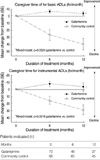1. Suh GH, Kim JK, Cho MJ. Community study of dementia in the older Korean population. Aust N Z J Psychiatry. 2003. 37:606–612.
2. Bores GM, Huger FP, Petko W, Mutlib AE, Camacho F, Rush DK, Selk DE, Wof V, Kosley RW Jr, Davis L, Vargas HM. Pharmacological evaluation of novel Alzheimer's disease therapeutics: acetylcholinesterase inhibitors related to galanthamine. J Pharmacol Exp Ther. 1996. 277:728–738.
3. Chu LW, Yik PY, Mok W, Chung CP. A 2-year open-label study of galantamine therapy in Chinese Alzheimer's disease patients in Hong Kong. Int J Clin Pract. 2007. 61:403–410.

4. Pirttila T, Wilcock G, Truyen L, Damaraju CV. Long-term efficacy and safety of galantamine in patients with mild to moderate Alzheimer's disease: multicentre trial. Eur J Neurol. 2004. 11:734–741.
5. Suh GH, Jung HY, Lee CU, Oh BH, Bae JN, Jung HY, Ju YS, Yeon BK, Park J, Hong I, Choi S, Lee HJ. A prospective, double-blind, community-controlled comparison of three doses of galantamine in the treatment of mild to moderate Alzheimer's disease in a Korean population. Clin Ther. 2004. 26:1608–1618.

6. American Psychiatric Association. Diagnostic and statistical manual of mental disorders. 1994. 4th ed. Washington, DC.: American Psychiatric Association.
7. McKhann G, Drachman D, Folstein M, Katzman R, Price D, Stadlan EM. Clinical diagnosis of Alzheimer's disease: report of the NINCDS-ADRDA Work Group under the auspices of Department of Health and Human Services Task Force on Alzheimer's Disease. Neurology. 1984. 34:939–944.

8. Folstein MF, Folstein SE, McHugh PR. "Mini-mental state": a practical method for grading the cognitive state of patients for the clinician. J Psychiatr Res. 1975. 12:189–198.
9. Rosen WG, Mohs RC, Davis KL. A new rating scale for Alzheimer's disease. Am J Psychiatry. 1984. 141:1356–1364.
10. Gelinas I, Gauthier L, McIntyre M, Gauthier S. Development of a functional measure for persons with Alzheimer's disease: the disability assessment for dementia. Am J Occup Ther. 1999. 53:471–481.

11. Suh GH. Development of the Korean version of the Disability Assessment for Dementia Scale. J Korean Geriatr Soc. 2003. 7:278–287.
12. Suh GH. Validation of the Korean version of the Alzheimer's Disease Assessment Scale. J Korean Geriatr Soc. 2003. 7:267–277.
13. Reisberg B, Borenstein J, Salob S, Ferris S, Franssen E, Georgotas A. Behavioral symptoms in Alzheimer's disease: phenomenology and treatment. J Clin Psychiatry. 1987. 48 :Suppl. 9–15.
14. Suh GH, Son HG, Shin H, Kim IM, Hong S, Park J, Choi IG, Kim SK, Yeon BK. Reliability and analysis of symptom category scores of the behavior pathology in Alzheimer's disease rating scale, Korean version (BEHAVE-AD-K). J Korean Geriatr Psychiatry. 2001. 5:50–57.
15. Reisberg B, Ferris SH, de Leon MJ, Crook T. The Global Deterioration Scale for assessment of primary degenerative dementia. Am J Psychiatry. 1982. 139:1136–1139.
16. Beecham J, Knapp M. Thornicroft G, editor. Costing psychiatric interventions. Measuring Mental Health Needs. 2001. 2nd edn. London: Gaskell;200–224.
17. Wimo A, Mastey V, Winblad B. Wimo A, Jonsson B, Karlsson G, Winblad B, editors. Evaluation of the healthcare resource utilization and caregiver time in antidementia drug trials-a quantitative battery. Health economics of dementia. 1998. Chichester, UK: John Wiley & Sons;465–499.
19. Choi BH, Sunwoo D, Choi HM. Report on the introduction of public long-term care insurance for the elderly in Korea. 2001. Seoul: Korean Institute of Health and Social Affairs.
20. National Health Insurance Corporation. Year 2002 National Health Insurance Statistical Yearbook. 2003. Seoul: National Health Insurance Corporation.
21. Ministry of Health and Welfare. Guideline for health and welfare program for the Elderly. 2004. Seoul: Ministry of Health and Welfare.
22. June KJ, Park JY. Cost-effectiveness analysis of home health care program for cerebrovascular accident patients. J Korean Community Nursing. 2001. 12:22–31.
23. Tariot PN, Solomon PR, Morris JC, Kershaw P, Lilienfeld S, Ding C. A 5-month, randomized, placebo-controlled trial of galantamine in AD. The Galantamine USA-10 Study Group. Neurology. 2000. 54:2269–2276.
24. Wilcock GK, Lilienfeld S, Gaens E. Efficacy and safety of galantamine in patients with mild to moderate Alzheimer's disease: multicentre randomised controlled trial. Galantmine International-1 Study Group. BMJ. 2000. 321:1445–1449.
25. Rockwood K, Mintzer J, Truyen L, Wessel T, Wilkinson D. Effects of a flexible galantamine dose in Alzheimer's disease: a randomised, controlled trial. J Neurol Neurosurg Psychiatry. 2001. 71:589–595.

26. Wilkinson D, Murray J. Galantamine: a randomized, double-blind, dose comparison in patients with Alzheimer's disease. Int J Geriatr Psychiatry. 2001. 16:852–857.

27. Suh GH, Ju YS, Yeon BK, Shah A. A longitudinal study of Alzheimer's disease: rates of cognitive and functional decline. Int J Geriatr Psychiatry. 2004. 19:817–824.

28. Aneshensel CS, Pearlin LI, Levy-Storms L, Schuler RH. The transition from home to nursing home mortality among people with dementia. J Gerontol B Psychol Sci Soc Sci. 2000. 55:S152–S162.

29. Jönsson L, Jönsson B, Wimo A, Whitehouse P, Winblad B. Second international pharmacoeconomic conference on Alzheimer's disease. Alzheimer Dis Assoc Disord. 2000. 14:137–140.

30. Getsios D, Caro JJ, Caro G, Ishak K. Assessment of health economics in Alzheimer's disease (AHEAD) Galantamine treatment in Canada. Neurology. 2001. 57:972–978.

31. Caro JJ, Salas M, Ward A, Getsios D, Mehnert A. Economic analysis of galantamine, a cholinesterase inhibitor, in the treatment of patients with mild to moderate Alzheimer's disease in the Netherlands. Dement Geriatr Cogn Disord. 2002. 14:84–89.

32. Pocock SJ. The combination of randomized and historical controls in clinical trials. J Chronic Dis. 1976. 29:175–188.









 PDF
PDF ePub
ePub Citation
Citation Print
Print


 XML Download
XML Download